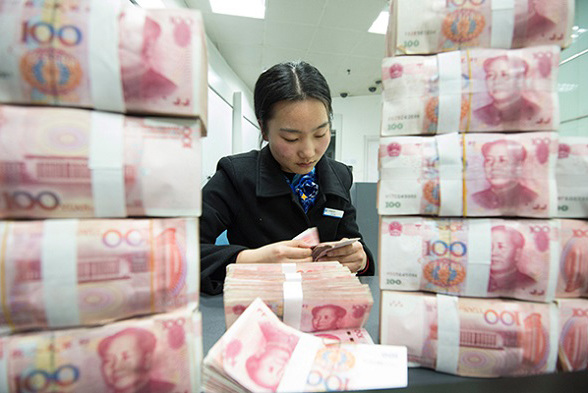
A clerk counts cash at a bank outlet in Hai'an county, Jiangsu province. (Photo/China Daily)
Expansion of new loans flat despite deleveraging, says the central bank
China's broad money supply maintained a low growth rate of 8.3 percent in April, along with flat new yuan loan expansion even as policymakers continued financial deleveraging, according to data from the People's Bank of China, the central bank, on Friday.
Last month's M2, or the broad measure of money supply covering cash in circulation and all deposits, missed market expectations of 8.5 percent and was only 0.1 percentage points higher than March's reading, but 1.5 percentage points lower than a year earlier.
Yuan-denominated new loans increased by 1.18 trillion yuan ($186.3 billion) in April, 79.7 billion yuan more from a month earlier, resulting in total outstandings of 126.16 trillion yuan, a year-on-year growth of 12.7 percent. It was slightly slower than the growth rate of 12.8 percent in March, the PBOC said.
Total social financing, which includes off-balance-sheet financing in addition to regular bank lending, increased by 1.56 trillion yuan, compared with the incremental amount of 1.33 trillion yuan in March and 1.17 trillion yuan in February, said the PBOC.
It was in line with the monetary authority's aim to control total money supply during the deleveraging process, but weaker credit growth and a too-tight financial environment may curb overall economic growth in a lagging period, said economists.
Possible economic weakening, due to negative impacts of financial tightening, could hurt economic growth, which requires policymakers to remain vigilant and make monetary policy more flexible, said Wang Yongli, academic committee member of International Monetary Institute in Renmin University of China.
Ruan Jianhong, head of the central bank's surveys and statistics department, said last month that data has shown a stabilized growth of M2, as a result of prudent and neutral monetary policy and effective regulatory coordination to prevent financial risks.
Financial deleveraging is proceeding smoothly, supported by the "reasonable" growth of M2 at the current pace, according to the PBOC official, given a stable money market interest rate level and sufficient liquidity in the banking system.
A fast expansion of monetary supply was seen by economists as the root cause of fast growth in credit during the post-crisis period. Financial regulators noted the importance of controlling the total money supply while retaining reasonable credit growth remained key for monetary policy this year.
In 2017, the country's broad money supply growth was 8.2 percent, much lower than the goal of 12 percent, which was also lower than the sum of the 6.9 percent GDP growth and 1.6 percent CPI.
By the end of last year, according to research by Herbert Poenisch, a former senior economist at the Bank for International Settlements, China's M2 outstanding reached 300 percent of GDP, compared with 75 percent in the US and nearly 100 percent in the eurozone even after years of quantitative easing.


















































